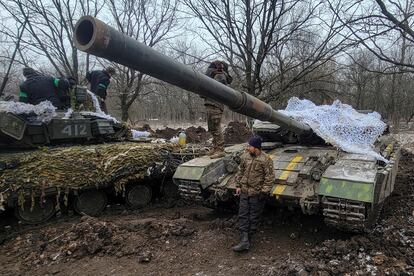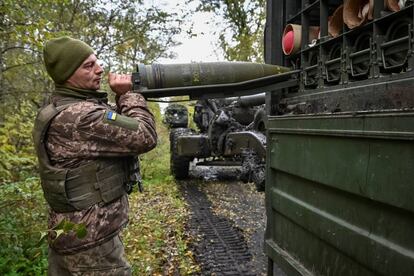Ukraine in race against time to launch spring offensive with NATO-supplied tanks
Moscow and Kyiv are both believed to be planning a major attack in the spring and heavy armor will be key to any successful assault on defensive lines of a scale not seen since World War II


Ukraine and Russia are engaged in a race against the clock to prepare their spring offensives, which both sides believe will be key in determining the future of the war. Whoever strikes first will gain the advantage of forcing the enemy’s plans to change. Valerii Zaluzhnyi, the commander-in-chief of the Armed Forces of Ukraine, is designing a counter-offensive that in his own words must serve to recover all of the territory lost to Russian forces since the beginning of the invasion last February and which is dependent on the delivery of NATO-supplied heavy armor.
There is a fundamental difference now compared to the successful Ukrainian counterattacks last summer and autumn on the Kharkiv and Kherson fronts. Since then, Russian forces have dug in to defensive positions on a size and scale not seen in Europe since World War II: lines stretching hundreds of miles with concrete pillboxes, moats for defensive tank positions, anti-armor barriers, machine gun nests and trenches with bunkers designed to withstand artillery barrages. For Ukrainian infantry to advance against such a fortified line, they will require the support of an armored attacking force that Kyiv currently lacks.
Ukraine’s NATO allies have been working to supply as much of this materiel as possible. Since last December there have been multiple announcements of the supply of light armored attack and infantry support vehicles, above all from Washington, which is sending Bradleys, Humvees and Strykers, as well as Germany’s Marders and France’s AMX-10s. Zaluzhnyi has said his forces need around 700 of these vehicles, of which EL PAÍS estimates 600 could arrive in the coming weeks. But while vehicles of this type were sufficient for previous counter-offensives, heavy tanks will be required to break Russia’s newly fortified lines.
Zaluzhnyi put the number of NATO-supplied main battle tanks needed at 300 last December. Ukraine currently has around 600 operational tanks, according to 2022 estimates by British defense and security analysts RUSI and Oryx, compared to 1,200 last March. Most of these vehicles are old Soviet models, such as the T-72 and T-64, which are in poor condition and have been in use since the Donbas conflict erupted in 2014. Ukrainian mechanized divisions also have some 450 captured Russian tanks, but less than a third of these have been recycled for combat. The remainder have been stripped for parts. Russia on the other hand has around 1,500 operational heavy tanks of which some, such as the T-90, T-80 BVM and T-64 BV, are on a par with NATO tanks.

Oleksiy Melnik, co-director of the Razumkov Centre in Kyiv, believes that the NATO heavy armor will be concentrated for a counter-offensive on a specific front. Based on information the center has received from military and government officials, he assumes that front will be Zaporizhzhia. CNN published a report on Tuesday that quoted US and NATO officials suggesting that Ukraine should abandon its defense of Bakhmut, in the Donetsk region, and concentrate on an attack in the south to sever the connection between the Russian border, the occupied territories in the Sea of Azov and Kherson, and position Kyiv’s forces at the gates of Crimea. “A major Ukrainian breakthrough in Zaporizhzhia would seriously jeopardize the viability of the land bridge between the Russian region of Rostov and Crimea,” the intelligence service of the British Ministry of Defense noted on January 8.
The southern front between Kherson and Dnipropetrovsk is at a standstill because the opposing armies are separated by one of the largest rivers in Europe, the Dnipro. A landing on the Russian-held bank would require a huge number of troops, artillery and amphibious vehicles. The alternative for Kyiv is Zaporizhzhia, a province the Dnipro also runs through and where Ukrainian forces still control part of the eastern bank. The terrain in Zaporizhzhia is flat and largely devoid of large urban concentrations, making it ideal for the advance of armored divisions, according to Thibault Fouillet, a French military officer and analyst at the Foundation for Strategic Research.
Fouillet concurs with Melnik that Kyiv will opt to concentrate the NATO tanks it receives on a single front. “We must take into account the Ukrainian way of waging war since the beginning of the conflict; each offensive was built on a massive concentration of deep fire [artillery], the progress of mechanized infantry and tanks,” Fouillet says. The analyst believes that both the front between Kharkiv and Luhansk and the Zaporizhzhia front are geographically optimal for a spring offensive, although he also considers the Zaporizhzhia option would be more decisive overall for the future of the war.
Fouillet estimates that Ukraine can expect around 100 NATO tanks ahead of spring, above all the European Leopard 2, the American Abrams and the British Challenger 2. The French analyst believes that the 300 tanks requested will take longer to amass, but would be sufficient for a new counter-offensive, and perhaps decisive. Melnik, on the other hand, suspects that Zaluzhnyi will prefer to wait and deploy the full 300 in the same attack.

The experts consulted for this article agree that the tanks Ukraine receives should be concentrated in a few regiments in order to streamline the supply chains of parts, fuel and ammunition from Poland. This would also be easier to achieve if those supply lines were directed to a single geographical area.
Small-scale Russian attacks in the region throughout January have reinforced the prediction that Zaporizhzhia will turn into the new hot spot in the war. If Ukraine were to make gains on this sector of the front, Russian supply lines on the Azov and Black Sea coast would come within range of Himars missiles, the most powerful artillery piece in use in the conflict, which have a range of around 50 miles. Kyiv has made repeated requests for longer-range missile systems, but Washington has proven reluctant to provide them for fear they could be used to launch strikes on Russian soil or Crimea, which the Kremlin has warned is a line that must not be crossed.
The weather is working against Kyiv, which has lost the opportunity to launch an attack in winter, when the frozen ground is more suitable for the movement of heavy armor. When the spring thaw comes, muddy terrain will hamper the functioning of tank tracks. Another question is how quickly NATO tanks will become operational on the front lines. Washington has announced the delivery of 31 Abrams despite its reservations about the suitability of the armor, which is technically considerably more complex than the tanks currently at Kyiv’s disposal, requires large amounts of fuel and is more difficult to train on than the German Leopards. According to a New York Times report published Wednesday, the Abrams could take months to be combat-ready.
Should Moscow launch its own offensive before Kyiv – Ukrainian intelligence is anticipating that any attack will come on the Donetsk front – and force Zaluzhnyi into a change of plans, experts also point out that Abrams are well-suited to a defensive role. What is beyond doubt, General Robert B. Abrams, whose father, General Creighton Abrams, the tank is named after, told The New York Times is that an Abrams will destroy most Soviet models. “They will put a hole in anything they want.”
Sign up for our weekly newsletter to get more English-language news coverage from EL PAÍS USA Edition
Tu suscripción se está usando en otro dispositivo
¿Quieres añadir otro usuario a tu suscripción?
Si continúas leyendo en este dispositivo, no se podrá leer en el otro.
FlechaTu suscripción se está usando en otro dispositivo y solo puedes acceder a EL PAÍS desde un dispositivo a la vez.
Si quieres compartir tu cuenta, cambia tu suscripción a la modalidad Premium, así podrás añadir otro usuario. Cada uno accederá con su propia cuenta de email, lo que os permitirá personalizar vuestra experiencia en EL PAÍS.
¿Tienes una suscripción de empresa? Accede aquí para contratar más cuentas.
En el caso de no saber quién está usando tu cuenta, te recomendamos cambiar tu contraseña aquí.
Si decides continuar compartiendo tu cuenta, este mensaje se mostrará en tu dispositivo y en el de la otra persona que está usando tu cuenta de forma indefinida, afectando a tu experiencia de lectura. Puedes consultar aquí los términos y condiciones de la suscripción digital.
More information
Archived In
Últimas noticias
Welcome to the post-religion era: The idea of Christianity as the absolute truth has become obsolete
‘I thought you would like it’: The risky sexual practice popularized by TV shows and TikTok
The digitalization of tourism: ‘They promise experiences and gave us the worst possible one’
Mexican peso defies uncertainty with forecasts of a new period of stability in 2026
Most viewed
- Sinaloa Cartel war is taking its toll on Los Chapitos
- Oona Chaplin: ‘I told James Cameron that I was living in a treehouse and starting a permaculture project with a friend’
- Reinhard Genzel, Nobel laureate in physics: ‘One-minute videos will never give you the truth’
- Why the price of coffee has skyrocketed: from Brazilian plantations to specialty coffee houses
- Silver prices are going crazy: This is what’s fueling the rally









































